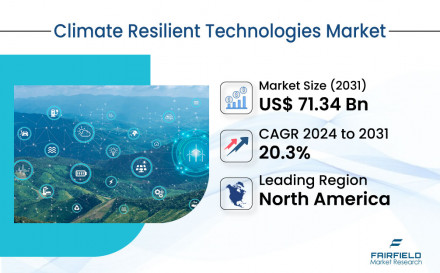気候変動に強い技術市場分析:地域別、業界別、主要プレーヤー別
As the world struggles with the increasingly severe effects of climate change, the global market for climate resilient technologies is poised to experience rapid growth. Valued at USD 19.56 billion in 2024 , the market is expected to surge to USD 71.34 billion by 2031 , expanding at a staggering CAGR of 20.3% over the forecast period. The increasing frequency of climate-related disasters, combined with stringent international regulatory frameworks, has made climate change adaptation a strategic priority for governments, businesses, and communities worldwide.
Read the full report here: https://www.fairfieldmarketresearch.com/report/climate-resilient-technologies-market

Market Insights
: The market outlook highlights a shift toward advanced solutions that address both immediate and long-term climate risks.
North America currently accounts for 35% of the market share, driven by technological innovation, government funding, and proactive disaster management initiatives . Global policy frameworks such as the European Green Deal and the U.S. Inflation Control Act have created significant opportunities for investment and adoption. Artificial intelligence ( AI ) and predictive analytics are redefining disaster preparedness and climate change adaptation strategies by enabling accurate forecasting, resource optimization, and emissions monitoring. Increased investments in resilient urban infrastructure, such as seawalls, green roofs, and permeable pavements, are shaping the sustainable cities of the future. Large enterprises dominate with a 55% share, owing to their ability to allocate significant budgets to advanced resilience solutions. Integrated and implemented solutions account for approximately 50 % of the market, reflecting the demand for seamless adoption of climate change adaptation technologies across sectors. Climate - smart agriculture is emerging as a key sector, with drought-resistant seeds, IoT -enabled irrigation, and precision agriculture solutions gaining global attention.
Key Growth Drivers:
1. Intensifying Climate-Related Disasters.
Natural disasters, such as hurricanes, wildfires, droughts, and floods, are becoming more frequent and severe due to global warming. These events have created unprecedented economic and social losses and stimulated demand for disaster-resilient technologies. Vulnerability is particularly high in urban areas, driving the adoption of urban resilience measures such as advanced drainage systems and fire-resistant materials.
2. Policy and Regulatory Drive .
Strong government mandates remain a key driver of growth.
The European Green Deal aims to achieve net-zero emissions by 2050 and has committed significant funding to renewable energy, sustainable construction, and carbon capture systems.
The U.S. Inflation Reduction Act allocated US$ 369 billion for clean energy and climate change adaptation , encouraging companies to adopt low-carbon, adaptive solutions.
Developing countries are increasingly focusing on urban planning, disaster risk reduction, and sustainable agriculture, creating opportunities for inclusive growth.
Key BarriersDespite
significant momentum, several challenges could slow market expansion:
• High upfront costs: Advanced resilience technologies require significant initial capital, posing a barrier to adoption in smaller municipalities and developing countries.
• Awareness and talent gaps: Low awareness of climate action, especially in rural and developing regions, and a shortage of skilled professionals to manage these technologies hinder large-scale adoption.
Business Opportunities
1. Artificial Intelligence in Climate Adaptation
AI -powered predictive analytics, disaster early warning systems, and resource optimization tools are creating transformative opportunities for businesses. Smart irrigation and AI -powered carbon monitoring are examples of the convergence of efficiency and sustainability.
2. Climate-Smart Agriculture With
food security in the global spotlight, climate-smart agricultural technologies bring resilience and productivity. Drought-resistant crops, IoT -enabled water management, and precision agriculture tools are receiving strong support from governments and institutions, especially in developing countries.
3. Resilient Urban
Infrastructure Growing investments in green building techniques, flood protection, and carbon-neutral materials are redefining infrastructure planning. Governments and private companies alike are prioritizing these solutions as part of their long-term sustainability strategies.
Regional Analysis
• North America: Maintaining its lead with a 35% market share, supported by strong funding frameworks such as the US Inflation Reduction Act, technological innovation, and ambitious net-zero targets set by companies . • Europe: Strong growth is expected, supported by comprehensive policies such as the European Green Deal and funding from Horizon Europe. European countries such as Germany, Spain, and Denmark are pioneers in the fields of renewable energy and sustainable infrastructure. • Asia Pacific: Expected to see the fastest growth, driven by large-scale R&D investments in climate-smart agriculture.
Request a sample copy of the report : https://www.fairfieldmarketresearch.com/report/climate-resilient-technologies-market/request-sample

